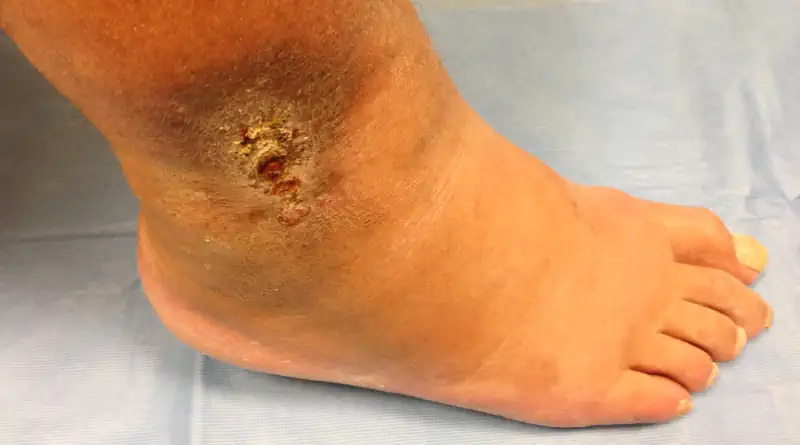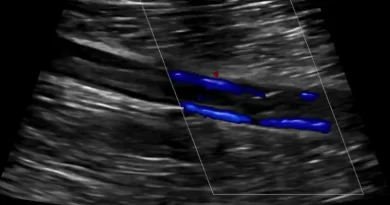Post Thrombotic Syndrome
A blood clot in the leg causes immediate symptoms. These symptoms include pain and swelling. But with time and with proper treatment, most of these symptoms will resolve. But, some people will develop long-term symptoms. When this happens, we call it the post thrombotic syndrome.
Post Thrombotic Syndrome Symptoms
The symptoms of the post thrombotic syndrome can be mild or severe. We can measure the severity of chronic symptoms by using the Villalta score. Another relevant score is the Venous Clinical Severity Score (VCSS).
Most people who have this syndrome will experience mild symptoms. But some will have more severe problems. The severe problems are not as common. But because deep vein thrombosis is so common, many thousands of people suffer from severe from this problem.
What are the Symptoms?
The symptoms of the post thrombotic syndrome include skin changes, leg swelling and pain:
- Skin changes – The skin will change color. In some cases, the skin can become angry at times. This can look as bad as a skin infection, cellulitis. With time the skin will become thin and brittle. It will also become dry and itchy. So, it is common for someone to scratch their itchy brittle skin and cause a wound. Once a wound happens it will be very hard to close.
- Leg swelling – It is not entirely clear why some people develop leg swelling and others do not. A deep vein thrombosis might ruin the vein valves in the leg. These valves cannot regenerate. So part of the problem is faulty valves. We also call this venous insufficiency. But not everyone who has faulty valves will also have leg swelling. So there is something else going on. We don’t really know what that something else is. It might have something to do with inflammation.
- Chronic pain – The pain of the post thrombotic syndrome is a dull ache. But it can be severe. The pain is worse as the day progresses. So it is common for people to complain of night leg pain. The pain will improve with leg elevation and with compression stockings .But for many people it will be severe enough to reduce their quality of life after a blood clot.

How Common is the Post Thrombotic Syndrome?
The post thrombotic syndrome is prevalent. The best estimates are that as many as 50% of people will develop at least some symptoms after a significant deep vein thrombosis. Perhaps as even 10% will have severe symptoms. While not unheard of, it is much less common after superficial thrombophlebitis.
We cannot predict who will develop chronic symptoms after a deep vein thrombosis. But we do know of a few factors that are linked to a higher chance of developing symptoms:
- Larger clot
- Proximal clot. This means the clot is higher up in the leg. More people will develop chronic symptoms after a clot in a thigh vein than after a clot in a calf vein.
- Delay in care. It is always important to treat blood clots early with a blood thinner. Delaying care will elevate the risk of the clot extending or even breaking off to the lungs. But delaying care also increases the risk of the post thrombotic syndrome.
- Leg clot (as opposed to a clot in the arm)
Post Thrombotic Syndrome Treatment
There are no good treatments for the post thrombotic syndrome. It cannot be reversed and there is no cure. So, we focus on symptom relief. For instance, compression stockings will help with leg swelling and with some of the pain during the day. Skin care with emollients will keep the skin as healthy as possible. It is important to identify and treat leg ulcers as soon as possible. Otherwise, they might grow and also an infection might set in.
There are medications that can affect chronic venous symptoms. These are called venoactive agents. One example is horse chestnut.
Prevention
The best way to prevent the post thrombotic syndrome is to prevent deep vein thrombosis. Unfortunately, this is not always possible. But once a blood clot happens, we don’t really know how to prevent some people from developing chronic symptoms. People have tried compression stockings, but that has not really worked. Still, more trials are ongoing, so there may be some news about this in the future.
For some people an intervention close to the time of the deep vein thrombosis can reduce chronic symptoms. The idea is to open the vein quickly after a clot forms. But the problem is that this does not work for everyone. So, the trick is to identify who to treat with these procedures. We don’t really have the answer to this question yet.
Inflammation
We know that a clot causes inflammation in the body and in the vein. We even have experiments in mice that show that we can prevent clots by preventing inflammation. There are early studies now that are looking into whether targeting inflammation will help prevent post thrombotic symptoms.



Pingback: Deep Vein Thrombosis: Symptoms, Diagnosis and Treatment
Pingback: Blood Clots After Flight: How to Prevent? When can I fly?
Pingback: Measuring Lower Extremity Clot in Research and Clinical Practice